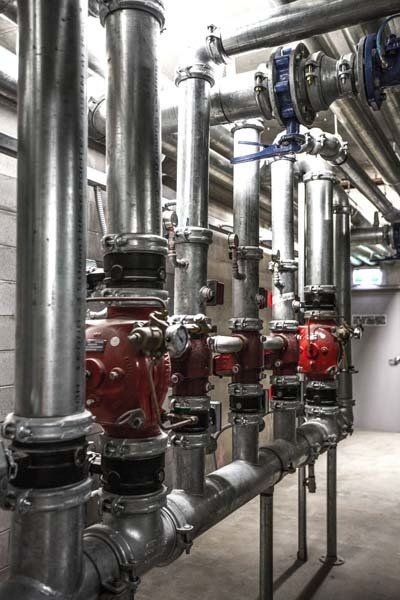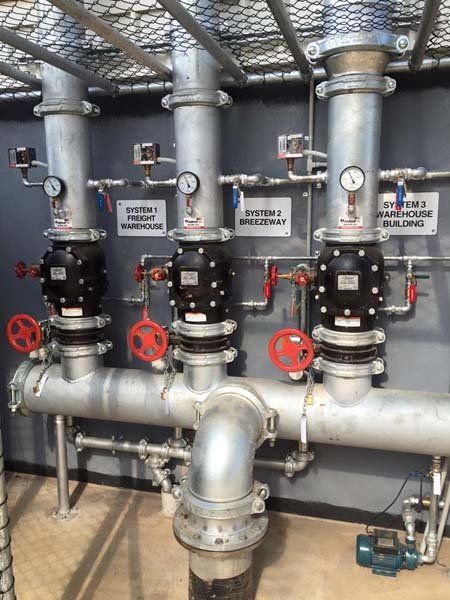BOOK A FREE
ON-SITE INSPECTION!
(08) 8340 7276
Adelaide
(08) 8947 2437 Darwin
(08) 8953 0820 Alice Springs
Fire Pumps & Tanks
FIRE PUMPS & TANKS
FIRE PUMPS & TANKS
SPECIALISED PUMPING AND WATER STORAGE SOLUTIONS ACROSS AUSTRALIA
DEFEND FIRE = SERVICE EXCELLENCE
DEFEND FIRE MANAGES YOUR ASSETS
WE UNDERSTAND FIRE PUMPS....
Fire pumps function either by an electric motor or a diesel engine. If the building configuration requires power independent of the local electric power grid, a pump using an electric motor may utilize the installation of an emergency backup generator.
The fire pump starts when the pressure in the fire sprinkler or hydrant system drops below a predetermined threshold. A sprinkler system pressure drops significantly when one or more fire sprinklers are exposed to heat above their design temperature, and opens, releasing water. A hydrant system pressure drops when a hydrant landing valve is opened and water is allowed to flow freely. Alternately, fire hose reels or other firefighting valves are opened, causing a pressure drop in the fire main. System leaks are also a culprit!
Fire pumps are needed when the local municipal water system (towns main) cannot provide sufficient pressure and/or flow to meet the hydraulic design requirements of the fire sprinkler or hydrant system. This usually occurs if the building is very tall, or in systems that require a relatively high pressure at the fire sprinkler in order to provide a large volume of water, such as in storage warehouses. Fire pumps are also needed if fire protection water supply is provided from a water storage tank.
THE DIFFERENT TYPES
There are five different pumps generally used for firefighting purposes, namely:
- Horizontal split case pumps
- Vertical split case pumps
- Vertical inline pumps
- Vertical turbine pumps
- End suction pumps
Each of these pumps require a driver. Standard drivers within the Australian market include:
- Diesel engines
- Electric motors

PROTECT YOUR ASSETS
Our in-house specialist diesel mechanic and skilled technicians can safeguard thorough testing and maintenance of your pumps, strictly adhering to Australian Standards AS1851.
We provide a start to finish solution to not only ensure your system is compliant, but to make sure the longevity of the equipment. Fire pumps and tanks are extremely expensive items to replace - and having to do so through poor maintenance or simple, unavoidable errors can be not only frustrating but financially debilitating.
Defend Fire has extensive experience when dealing with fire pumps and water storage tanks of all sizes, types and locations. We can provide you with obligation free advice to make sure you're informed of system conditions and have the power of knowledge to help you through the tough decisions.
BOOK A
FREE
ON-SITE INSPECTION AND QUOTE NOW !
FIRE TANK SOLUTIONS
When fire pumps are required it is very likely that a fire water tank will be needed too. Fire tanks are used for storage of water for firefighting purposes and range in size from small 10kl break tanks to Mega-Litre full capacity tanks.
Water storage for fire protection is governed by the Australian Standards AS2304 with respect to design, capacity, construction, installation, commissioning and maintenance. Tanks have vastly different capacities to meet the specific site requirements and can be constructed in a number of different ways. Such as:
- Galvanised Steel Round Tanks
- Rectangular Panel Tanks
- Glass Fibre Reinforced Plastic Tanks
- In-built Concrete Tanks
- PVC Moulded Tanks (Break Tanks Only - and only when approved)
- Custom Designed and Built Tanks
ENSURING QUALITY
Defend Fire insists on quality with respect to fire pumps and tanks to ensure their reliability. We will assist with supplying equipment which considers your respective budget, as far as possible, while still meeting compliance - but with an overarching emphasis on ensuring a quality product.

BOOK A
FREE
ON-SITE INSPECTION & QUOTE TODAY!
Contact Us
Thank you for contacting us.
We will get back to you as soon as possible
We will get back to you as soon as possible
Oops, there was an error sending your message.
Please try again later
Please try again later
